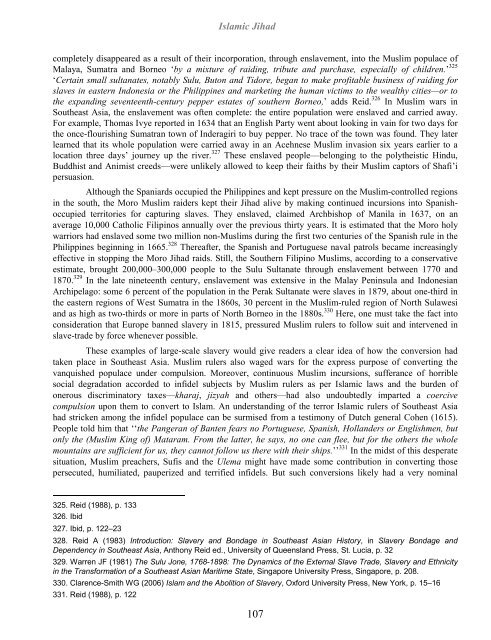islamic-jihad-legacy-of-forced-conversion-imperialism-slavery
islamic-jihad-legacy-of-forced-conversion-imperialism-slavery
islamic-jihad-legacy-of-forced-conversion-imperialism-slavery
- No tags were found...
Create successful ePaper yourself
Turn your PDF publications into a flip-book with our unique Google optimized e-Paper software.
Islamic Jihadcompletely disappeared as a result <strong>of</strong> their incorporation, through enslavement, into the Muslim populace <strong>of</strong>Malaya, Sumatra and Borneo ‘by a mixture <strong>of</strong> raiding, tribute and purchase, especially <strong>of</strong> children.’ 325‘Certain small sultanates, notably Sulu, Buton and Tidore, began to make pr<strong>of</strong>itable business <strong>of</strong> raiding forslaves in eastern Indonesia or the Philippines and marketing the human victims to the wealthy cities—or tothe expanding seventeenth-century pepper estates <strong>of</strong> southern Borneo,’ adds Reid. 326 In Muslim wars inSoutheast Asia, the enslavement was <strong>of</strong>ten complete: the entire population were enslaved and carried away.For example, Thomas Ivye reported in 1634 that an English Party went about looking in vain for two days forthe once-flourishing Sumatran town <strong>of</strong> Inderagiri to buy pepper. No trace <strong>of</strong> the town was found. They laterlearned that its whole population were carried away in an Acehnese Muslim invasion six years earlier to alocation three days’ journey up the river. 327 These enslaved people—belonging to the polytheistic Hindu,Buddhist and Animist creeds—were unlikely allowed to keep their faiths by their Muslim captors <strong>of</strong> Shafi’ipersuasion.Although the Spaniards occupied the Philippines and kept pressure on the Muslim-controlled regionsin the south, the Moro Muslim raiders kept their Jihad alive by making continued incursions into Spanishoccupiedterritories for capturing slaves. They enslaved, claimed Archbishop <strong>of</strong> Manila in 1637, on anaverage 10,000 Catholic Filipinos annually over the previous thirty years. It is estimated that the Moro holywarriors had enslaved some two million non-Muslims during the first two centuries <strong>of</strong> the Spanish rule in thePhilippines beginning in 1665. 328 Thereafter, the Spanish and Portuguese naval patrols became increasinglyeffective in stopping the Moro Jihad raids. Still, the Southern Filipino Muslims, according to a conservativeestimate, brought 200,000–300,000 people to the Sulu Sultanate through enslavement between 1770 and1870. 329 In the late nineteenth century, enslavement was extensive in the Malay Peninsula and IndonesianArchipelago: some 6 percent <strong>of</strong> the population in the Perak Sultanate were slaves in 1879, about one-third inthe eastern regions <strong>of</strong> West Sumatra in the 1860s, 30 percent in the Muslim-ruled region <strong>of</strong> North Sulawesiand as high as two-thirds or more in parts <strong>of</strong> North Borneo in the 1880s. 330 Here, one must take the fact intoconsideration that Europe banned <strong>slavery</strong> in 1815, pressured Muslim rulers to follow suit and intervened inslave-trade by force whenever possible.These examples <strong>of</strong> large-scale <strong>slavery</strong> would give readers a clear idea <strong>of</strong> how the <strong>conversion</strong> hadtaken place in Southeast Asia. Muslim rulers also waged wars for the express purpose <strong>of</strong> converting thevanquished populace under compulsion. Moreover, continuous Muslim incursions, sufferance <strong>of</strong> horriblesocial degradation accorded to infidel subjects by Muslim rulers as per Islamic laws and the burden <strong>of</strong>onerous discriminatory taxes—kharaj, jizyah and others—had also undoubtedly imparted a coercivecompulsion upon them to convert to Islam. An understanding <strong>of</strong> the terror Islamic rulers <strong>of</strong> Southeast Asiahad stricken among the infidel populace can be surmised from a testimony <strong>of</strong> Dutch general Cohen (1615).People told him that ‘‘the Pangeran <strong>of</strong> Banten fears no Portuguese, Spanish, Hollanders or Englishmen, butonly the (Muslim King <strong>of</strong>) Mataram. From the latter, he says, no one can flee, but for the others the wholemountains are sufficient for us, they cannot follow us there with their ships.’’ 331 In the midst <strong>of</strong> this desperatesituation, Muslim preachers, Sufis and the Ulema might have made some contribution in converting thosepersecuted, humiliated, pauperized and terrified infidels. But such <strong>conversion</strong>s likely had a very nominal325. Reid (1988), p. 133326. Ibid327. Ibid, p. 122–23328. Reid A (1983) Introduction: Slavery and Bondage in Southeast Asian History, in Slavery Bondage andDependency in Southeast Asia, Anthony Reid ed., University <strong>of</strong> Queensland Press, St. Lucia, p. 32329. Warren JF (1981) The Sulu Jone, 1768-1898: The Dynamics <strong>of</strong> the External Slave Trade, Slavery and Ethnicityin the Transformation <strong>of</strong> a Southeast Asian Maritime State, Singapore University Press, Singapore, p. 208.330. Clarence-Smith WG (2006) Islam and the Abolition <strong>of</strong> Slavery, Oxford University Press, New York, p. 15–16331. Reid (1988), p. 122107


